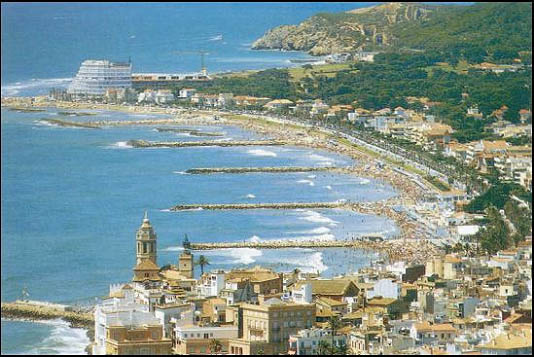| Sitges - Spain |
| Complete description
of case study |
PHOTO OF THE SITE
 |
|
CASE STUDY
| Title | Sitges |
| National level | Spain |
| Regional level | Catalonia autonomous community, Barcelona province |
| Local level | Garraf |
ABSTRACT
|
The town of Sitges is located on the Mediterranean coast, 40km south of Barcelona. It has a coastal area of 18.840km long, which is made of cliffs and sandy beaches. There are 18 pocket beaches in the municipality’s coastal area, 10 of which are in front of the urban area. Beach and bottom sediments are sands of siliciclasthic origin, of light gold colour and fine to medium grain size. The driving forces that cause erosion in the coast are mainly the lack of sediment transport by the southwestwards longshore drift, and the east storms, combined with the effect of numerous groins and breakwaters, and marina docks, which retain sediments in their leeside. The major
impact of the erosion is the loss of beach surface. Sitges economy depend
enormously on tourism (basically the summer tourism), so the loss of beach
is the main worry for all the stakeholders involved. Quarries and recreational
ports are other economic sectors of the municipality. To face erosion,
the policy adopted by the government is hold the line. The measures adopted
are both hard measures, such as groynes, detached breakwaters, T-shaped
breakwaters, artificial islands and seawalls, and soft measures (beach
renourishment). The numerous groynes retain the sediments that circulate
in a NE-SW longshore drift, avoiding the feeding of the southwest beaches,
which are the most affected by erosion, and worsening the problem of erosion.
The marina docks northly, deviate to the offshore a huge part of the sediment
load carried by longshore drift. |
BASIC INFORMATION
| Coastal characteristics |
|
| Policy options | Hold the line |
| Socio-economic activities | Tourism, industry, marinas. |
| Engineering techniques | Detached breakwaters, T-shaped breakwaters, groynes, artificial islands, beach nourishment |
SOURCE
| Name | Jordi Serra Raventós |
| Institution |
Universitat Autónoma de Barcelona Institut de Ciència i Tecnologia Ambientlas - ICTA |
| Address | Torre
C5 parell – 4th floor – Facultat Ciències – Campus UAB E-08193 Bellaterra (Barcelona) SPAIN |
| Telephone / fax | +34 93 581 3868 / +34 93 581 3331 |